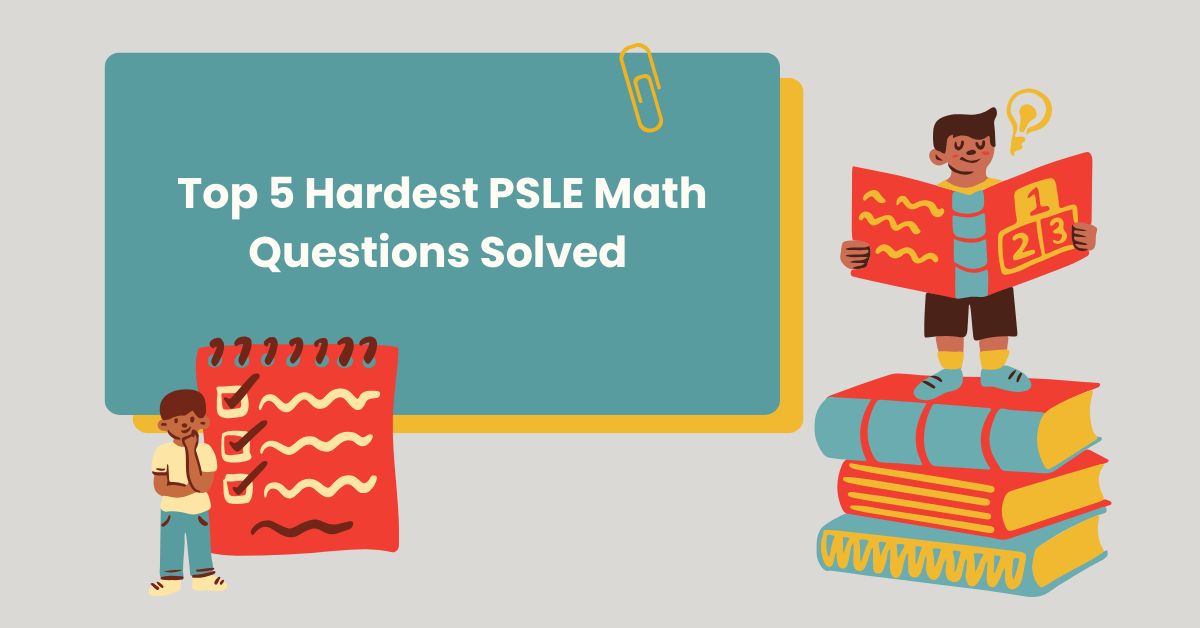Welcome to Explico, your trusted resource for mastering PSLE Math! Today, we’re diving deep into some of the toughest PSLE Math questions from the 2023 paper, providing you with detailed, step-by-step solutions that will help you understand the underlying concepts. Whether you’re a student preparing for the exam or a parent helping your child, this blog will break down the most challenging questions to ensure you’re well-prepared for the PSLE Math.
Introduction to PSLE Math Challenges
The Primary School Leaving Examination (PSLE) is a significant milestone in a Singaporean student’s academic journey. Among the various subjects tested, Math is often seen as one of the most challenging due to its complex problem-solving nature. However, with the right approach and strategy, even the toughest problems can be solved!
In this blog, we will focus on the Top 5 Hardest PSLE Math Questions from 2023. These questions are known for testing both basic arithmetic and higher-order thinking skills, such as critical reasoning and problem analysis. We will guide you through each problem step by step, highlighting the key concepts involved.
Question 1: Fractions and Percentage Problem
Problem:
In a school, 3/5 of the students are girls. Of the girls, 40% attend the Science Club, and the rest attend the Math Club. If the total number of students in the school is 600, how many girls are in the Math Club?
Solution:
- Find the total number of girls in the school:
- Since 3/5 of the students are girls, we multiply 3/5 by the total number of students (600).
- \text{Number of girls} = \frac{3}{5} \times 600 = 360 ]
- Calculate the number of girls in the Science Club:
- 40% of the girls attend the Science Club.
- \text{Girls in Science Club} = 40% \times 360 = 0.4 \times 360 = 144 ]
- Find the number of girls in the Math Club:
- The remaining girls must be in the Math Club. Subtract the girls in the Science Club from the total number of girls.
- \text{Girls in Math Club} = 360 – 144 = 216 ]
Answer: There are 216 girls in the Math Club.
Question 2: Ratio and Proportion Problem
Problem:
The ratio of the number of red balls to blue balls in a box is 3:4. If there are 84 balls in total, how many red balls are there?
Solution:
- Represent the ratio:
- The ratio of red balls to blue balls is 3:4, which means for every 3 red balls, there are 4 blue balls.
- The total parts in the ratio = 3 + 4 = 7 parts.
- Set up the equation:
- Let the total number of balls be 84.
- Since the ratio is divided into 7 parts, each part represents 847=12\frac{84}{7} = 12784=12 balls.
- Calculate the number of red balls:
- The red balls are represented by 3 parts.
- \text{Number of red balls} = 3 \times 12 = 36 ]
Answer: There are 36 red balls.
Question 3: Speed, Time, and Distance Problem
Problem:
Two trains, Train A and Train B, start from the same point at the same time. Train A travels at 60 km/h, and Train B travels at 80 km/h. After how many hours will Train B be 60 km ahead of Train A?
Solution:
- Set up the relationship between the two trains:
- The relative speed between the two trains is the difference in their speeds.
- \text{Relative speed} = 80 , \text{km/h} – 60 , \text{km/h} = 20 , \text{km/h} ]
- Use the formula for distance:
- Distance = Speed × Time.
- The distance Train B needs to be ahead of Train A is 60 km. Using the relative speed:
- \text{Time} = \frac{\text{Distance}}{\text{Relative speed}} = \frac{60 , \text{km}}{20 , \text{km/h}} = 3 , \text{hours} ]
Answer: Train B will be 60 km ahead of Train A after 3 hours.
Question 4: Algebraic Expression Problem
Problem:
The sum of three consecutive integers is 57. What are the three integers?
Solution:
- Represent the integers algebraically:
- Let the first integer be xxx, the second integer be x+1x + 1x+1, and the third integer be x+2x + 2x+2.
- Set up the equation:
- The sum of the three integers is 57.
- x + (x + 1) + (x + 2) = 57 ]
- Simplify and solve for xxx:
- 3x + 3 = 57 ]
- Subtract 3 from both sides:
- 3x = 54 ]
- Divide by 3:
- x = 18 ]
- Find the three integers:
- The first integer is x=18x = 18x=18, the second is x+1=19x + 1 = 19x+1=19, and the third is x+2=20x + 2 = 20x+2=20.
Answer: The three consecutive integers are 18, 19, and 20.
Question 5: Geometry Problem (Area of Triangle)
Problem:
A triangle has a base of 10 cm and a height of 6 cm. What is the area of the triangle?
Solution:
- Use the area formula for a triangle:
- The area AAA of a triangle is given by the formula:
- A=12×Base×HeightA = \frac{1}{2} \times \text{Base} \times \text{Height}A=21×Base×Height
- Substitute the given values:
- Base = 10 cm, Height = 6 cm.
- A = \frac{1}{2} \times 10 \times 6 = \frac{1}{2} \times 60 = 30 , \text{cm}^2 ]
Answer: The area of the triangle is 30 cm².
Final Words
These five problems from the 2023 PSLE Math paper demonstrate the diverse range of skills required to excel in the exam. From fractions and percentages to geometry and algebra, each question tests different areas of mathematical knowledge. The key to success in PSLE Math is practice, understanding the concepts, and applying logical steps to solve each problem.
We hope this walk-through helps you feel more confident in tackling even the hardest questions. Keep practicing and reviewing, and remember that every mistake is just a step closer to mastering the subject.
Stay tuned to Explico for more in-depth explanations, sample solutions, and tips to ace your PSLE Math!


